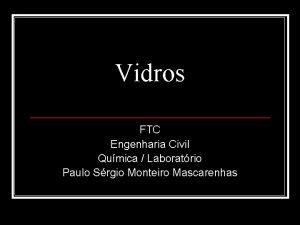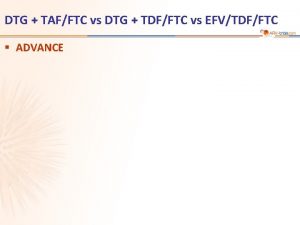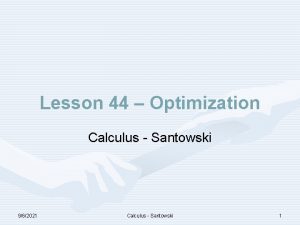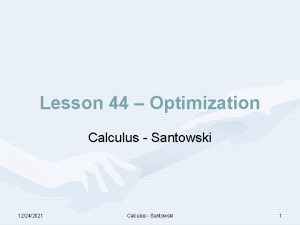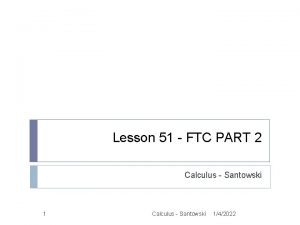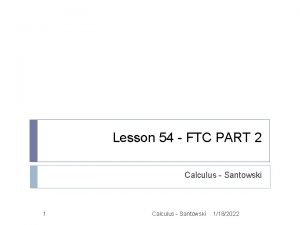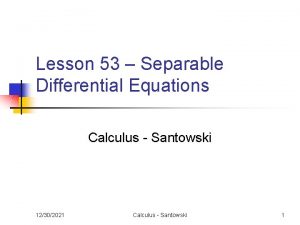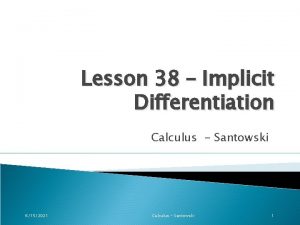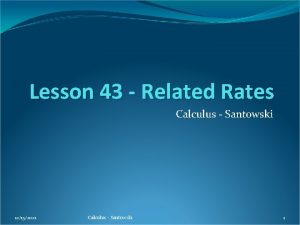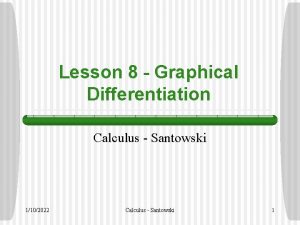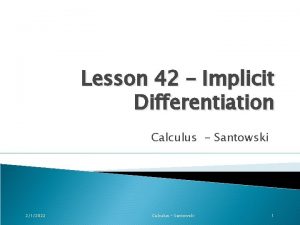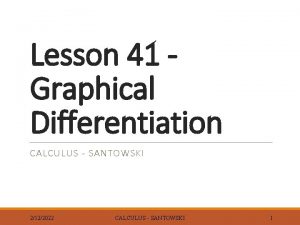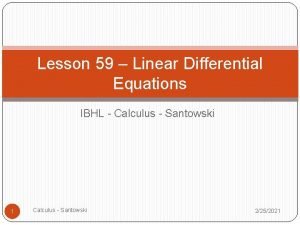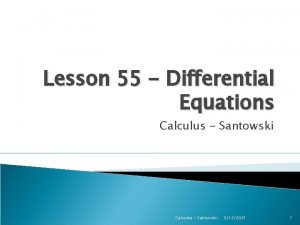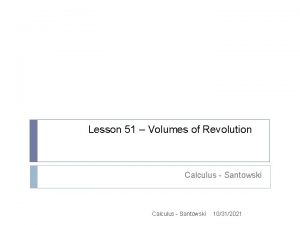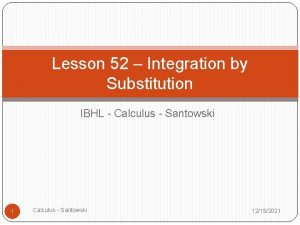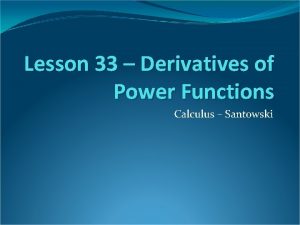Lesson 51 FTC PART 2 Calculus Santowski 12302021

















![FTC, Part 2 If f is continuous on [a, b] then the fcn has FTC, Part 2 If f is continuous on [a, b] then the fcn has](https://slidetodoc.com/presentation_image_h2/3f8ea005e0041677cacdf9206ef684d6/image-18.jpg)








- Slides: 26

Lesson 51 - FTC PART 2 Calculus - Santowski 12/30/2021

Review We have seen a definition/formula for a definite integral as where F’(x) = f(x) (or F(x) is the antiderivative of f(x) And have seen an interpretation of the definite integral as a “net/total change” 2 Calculus - Santowski 12/30/2021

FTC, PART 1 Some textbooks/resources refer to this statement as the Integral Evaluation Theorem as it tells us HOW to evaluate the definite integral by finding antiderivatives 3 Calculus - Santowski 12/30/2021

A Graphic Representation We need to visualize our equations & terms to keep our ideas clear in our minds Our function in question will be y = f(t) The area under the curve of y = f(t) we have called A(x), but it will now be called g(x) 4 So here is the graph: Calculus - Santowski 12/30/2021

A Graphic Representation 5 So, as we have done in past exercises, the value of the upper limit (b) is being varied – its value is changing from anywhere between a and b (i. e. a < x < b) Therefore, the area is constantly changing as a result of the value of x in other terms, the area is a function of the value of x hence A(x) or rather now g(x) So here is the graph: Calculus - Santowski 12/30/2021

A Graphic Representation of the Area Function Let’s work with the area under the curve f(t) = t 2, starting from x = 0 so our integral will be Now, let’s set the upper limit to x = 1 and we get 6 Calculus - Santowski 12/30/2021

A Graphic Representation of the Area Function Now, let’s set the upper limit to x = 2 and we get Now, let’s set the upper limit to x = 3 and we get 7 Calculus - Santowski 12/30/2021

A Graphic Representation of the Area Function Now, let’s set the upper limit to x = 4 and we get Now, let’s set the upper limit to x = 5 and we get 8 Calculus - Santowski 12/30/2021

A Graphic Representation from Before Now that we have seen x a few calculations and some “data points”, let’s see what we really have ? ? ? Area 9 0 1 2 3 0 1/3 8/3 27/3 4 5 64/3 125/3 We have the function Calculus - Santowski 12/30/2021

FTC, Part 2 So what does Try this as a simple contrast we have looked as integration as a process that generates fixed numbers (that correspond to net areas under curves) Now, with a different notion the value of the upper limit is variable, we are now considering as a FUNCTION, not a single number What does the function represent the antiderivative of y = f(t) 10 REALLY mean? ? Calculus - Santowski 12/30/2021

FTC, Part 2 So here’s the shift in our understanding the expression IS AN EXPRESSION for the antiderivative of y = f(t) which graphically could be understood as a cumulative AREA function 11 Calculus - Santowski 12/30/2021

A Clarifying Example (I Hope) Let’s go back to y = f(t) = t 2 between a = 0 and b = 5 So we have worked out the integral So now as the value of b changes, we get Where the antiderivative (1/3 x 3) can be used to evaluate for the area under the curve 12 Calculus - Santowski 12/30/2021

A Clarifying Example (I Hope) So we need to recognize the equivalence of the following 2 statements: In one statement, the antiderivative is given as a simple, explicit function, in the other, the antiderivative function is defined as an integral of f(t) To become consistent in our notations, I will switch the statements to 13 Calculus - Santowski 12/30/2021

A Clarifying Example (I Hope) Let’s work with the function So, again, if y(t) = 4 t-2 represents a derivative of some function, let’s find that other function in other words, let’s find the antiderivative of y(t) We know the antiderivative to be Y(t) = -4 t-1 + c Note that we could have asked the SAME thing as an indefinite integral 14 Calculus - Santowski 12/30/2021

A Clarifying Example (I Hope) Let’s work with the graph of the antiderivative of on DESMOS 15 Calculus - Santowski 12/30/2021

A Clarifying Example (I Hope) Let’s work with the graph of the antiderivative of on DESMOS Notice that the antiderivative equation has been presented in a different manner as an integral!! 16 Calculus - Santowski 12/30/2021

A Clarifying Example (I Hope) Let’s work with the graph of the antiderivative of on DESMOS in the form of 17 Calculus - Santowski 12/30/2021
![FTC Part 2 If f is continuous on a b then the fcn has FTC, Part 2 If f is continuous on [a, b] then the fcn has](https://slidetodoc.com/presentation_image_h2/3f8ea005e0041677cacdf9206ef684d6/image-18.jpg)
FTC, Part 2 If f is continuous on [a, b] then the fcn has a derivative at every point in [a, b] and So what does this really mean Every continuous function f(x) HAS an antiderivative (which simply happens to be expressed as an integral as: ) rather than explicitly in terms of elementary functions! 18 Calculus - Santowski 12/30/2021

Using the FTC, Part 2 Find the derivative of the following functions For all real numbers of x, define Evaluate 19 and interpret Calculus - Santowski 12/30/2021

Using the FTC, Part 2 Find the derivative of the following functions (Composites) 20 Calculus - Santowski 12/30/2021

Using the FTC, Part 2 Find dy/dx if: Find a function, y = f(x) with a derivative of that satisfies the condition f(3) = 5 21 Calculus - Santowski 12/30/2021

Using the FTC Given the function f be as shown and let (a) Evaluate g(0), g(2), g(4), g(7) and g(9) and g(11) (b) On what intervals is g increasing? (c) Where does g have a maximum value? (d) Sketch a rough graph of g(x) 12/30/2021 Calculus - Santowski 22

Using the FTC, Part 2 Graph the function defined by Address the following in your solution: (i) determine and discuss F’(x) (ii) determine and discuss F’’(x) (iii) find symmetry of F(x) (iv) estimate some points using trapezoid sums 23 Calculus - Santowski 12/30/2021

Using the FTC, Part 2 We can use the methods of differential calculus to analyze these functions!! Find the interval on which the curve is concave up Find the interval on which the curve is increasing 24 Calculus - Santowski 12/30/2021

Using the FTC, Part 2 Given that (a) Find all critical points of F (b) Determine the interval on which F increase and F decreases (c) Determine the intervals of concavity and inflection points of F (d) Sketch a graph of F 25 Calculus - Santowski 12/30/2021

FTC, Part 2 What is the advantage of defining an antiderivative as an integral? => we can then simply use our numerical integration methods (RRAM, LRAM etc) to estimate values https: //docs. google. com/viewer? a=v&pid=sites&srcid =ZGVm. YXVsd. GRvb. WFpbnxhc. GNhb. GN 1 b. HVz. ZXhh b. XF 1 ZXN 0 a. W 9 uc 3 xne. Do 1 OWY 1 ZTE 4 N 2 Vk. Mjk 5 N m. Zi 26 Calculus - Santowski 12/30/2021
 Mark seidman
Mark seidman Driver station ftc
Driver station ftc Ftc engenharia civil
Ftc engenharia civil Unity ftc omni
Unity ftc omni Tdf/ftc/efv
Tdf/ftc/efv Ftc blocks programming
Ftc blocks programming Android studio ftc
Android studio ftc Ftc engineering notebook examples
Ftc engineering notebook examples Ftc rn number
Ftc rn number Hardware map ftc
Hardware map ftc Ftc engineering notebook
Ftc engineering notebook Frc team 1717
Frc team 1717 Android studio ftc
Android studio ftc Part part whole addition
Part part whole addition Part to part ratio definition
Part to part ratio definition Brainpop ratios
Brainpop ratios Technical object description example
Technical object description example Vodka chimney glass
Vodka chimney glass The part of a shadow surrounding the darkest part
The part of a shadow surrounding the darkest part Minitab adalah
Minitab adalah Vertex angles of a kite
Vertex angles of a kite Graphing linear inequalities quiz
Graphing linear inequalities quiz The acts of the apostles part 1
The acts of the apostles part 1 Lesson 19 the acts of the apostles part 1
Lesson 19 the acts of the apostles part 1 Negative conditional sentences
Negative conditional sentences Ap calculus ab jeopardy
Ap calculus ab jeopardy Shell method calculus formula
Shell method calculus formula


